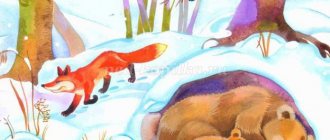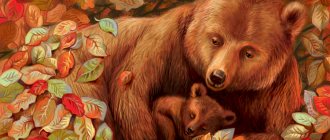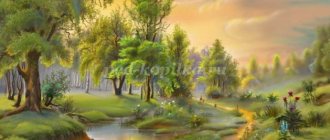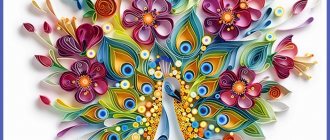Summary of GCD in the 2nd junior group: Wild animals
GCD in the second junior group of kindergarten
Objectives: Educational:
To consolidate children's knowledge about wild animals, their appearance, and the peculiarities of their habits.
Fix the names of the cubs. Specify the name of the dwelling. Consolidate knowledge about basic geometric shapes (circle, square, triangle); about the primary colors (red, blue, yellow, green) and shade - gray. Developmental:
Develop coherent dialogical speech, the ability to coordinate different parts of speech.
Develop attention, memory, thinking. Develop children's creative abilities; Ability to work neatly and cleanly with paints. Educational:
Foster love for the world around us;
Feeling of compassion, desire to help; Cultivate neatness and cleanliness. Equipment:
“Forest” decoration, supplies of squirrels and mushrooms. Slideshow on the projector “Inhabitants of the Forest” For each child, a landscape sheet with the image of a white hare, gray gouache paints, cotton swabs, napkins.
Progress of activities
V.: What a good day today, guests have come to us, let's say hello the way we know how: “Hello, palms - clap, clap, clap. Hello, legs - top, top, top. Hello, cheeks - splash, splash, splash. Round cheeks - splash, splash, splash. Hello, sponges - smack, smack, smack. Hello, teeth - click, click, click. Hello, my nose is bi, bi, bi. Hello, dear guests - hello. Mail: “Come urgently, help urgently! Miracles happen, we cannot divide the forest. The wizard scared us, he bewitched us all. We have forgotten who we are, what we should drink and what we should eat. Help us out, come and make peace between us urgently!” Forest inhabitants. Q: What are the names of the animals that live in the forest? (wild) Q: What wild animals do you know? Q: Why are they called wild? V.: some wizard bewitched all the animals, now they don’t know who they are, what they should eat, where to live, and most importantly, they don’t recognize their cubs. They ask us for help, shall we help? Q: But what can you use to go into the forest? Let's remember what types of transport we know. V.: They travel long distances by plane, the train travels on rails, they sail on the sea by ship, few people can fit in the car. Q: Are there many of us or few? Q: There are a lot of us, and the forest is not far, what can we all ride at the same time? V.: To go by bus, you need to buy tickets and sit in the place where the same figure of the same color is depicted (geometric shapes are glued to the chairs: a square, a circle and a triangle in red, yellow, blue and green colors) An inspector comes in and checks randomly tickets. The song “Bus” by V. sounds: it seems that we have arrived, listen to how the birds sing, how it smells in the forest. It’s very beautiful here, but I don’t see a single forest dweller. The animals are probably very confused, because they have forgotten who they are. 1 slide. Bear.
- who is this? -Tell me, children, what kind of bear is it? (big, brown,
kind, he has powerful paws, small ears) - what is the name of the cub? -What does he like to eat? - but in winter there is no honey and berries, what does the bear do? -Where does he sleep? 2 slide. Bear in a den.
V.: Oh, look, under the bush, under the bush there is Someone with a red tail. Who do you think it is? , 3rd slide Fox.
Q: Look at the fox and tell me what it is like. The fox is red, beautiful, cunning. She has a fluffy, long tail. She is often called plutovka, which means a deceiver. The fox does not change its coat; it is red both in summer and winter. -What is the name of the cub? 4 slide. Nora.
There is a fox's house under the bush. What is the name of the fox's house? V.: The entrance to the hole is narrow, long, and inside the hole is spacious and comfortable. Q: Who knows why the fox needs such a fluffy tail? (cover tracks) V.: let’s show together how a fox walks and covers its tracks. Physical exercise. The fox walked through the forest, made song calls, the fox tore the stripes, the fox wove bast shoes, walked near the Christmas tree, and what did you find on the Christmas tree? Mushrooms? Q: Do mushrooms grow on the Christmas tree? Q: What grows on the Christmas tree? (cones and needles)Where do mushrooms grow? (on the ground) V.: then whose mushrooms are these? (squirrel reserves) Where is the squirrel itself? 5 slide. Squirrel
V.: here she looks at us and asks for help, because she has forgotten who she is. Come on, guys, we'll tell you about her. What kind of coat does a squirrel have? (red, fluffy) Ears, tail? What is a baby squirrel called? (little squirrel) What is the name of her house? (hollow) 6 slide. Squirrel in a hollow.
V.: squirrels make themselves a house high in a tree. Let's show together how high it is. (We stand on our toes) Q: Why do you think the squirrel’s house is so high? (so that other animals cannot get to her or her supplies) V.: All animals have their own houses: the bear has a den, the fox has a hole, the squirrel has a hollow, but where does the hare live? What kind of house does he have? V.: The bunny doesn’t have a house, he slept under a bush and ran away, so he runs fast because there is nowhere to hide. Slide 7 The hare is white.
V.: Here is the bunny, let's look at it together. What kind of ears, tail, fur coat does he have? V.: The hare is a real fashionista: in winter he wears a white fur coat, and in summer he wears a gray one. Why do you think? (to make it easier to hide) Oh, trouble! It’s already spring, but the hare still hasn’t changed his coat, we need help. Painting a white hare gray (using the “poking” method with cotton swabs) 8 slide . The hare is gray.
V.: Look, the hare is already gray, we helped him. Great job guys, well done! Oh, he's already galloped away. Slide 9 Wolf
V.: Another resident showed up. Gray, scary and toothy. Caused a commotion. All the animals ran away. Scared the animals... V.: tell me what he is like? Slide 11 Lair.
V.: The wolf also has a home, look at what it is like. His home is called a lair. Sad music sounds and a wizard appears. V.: wizard, what happened, why are you so sad? Wizard: Yesterday I accidentally bewitched all the animals in the forest. I can’t cast the spell back - I forgot the words. V.: Don’t worry, wizard, we have already helped all the animals. We reminded them who they are, where they live and what they like to eat. V.: Guys, let's tell the wizard what animals we helped. Wizard: Thank you very much, you helped me out so much. Who are you and where did you come from? (from kindergarten) Wizard: what are you doing there? Show how you can dance. Dance “Stamp, my foot” Wizard: my time has come to please you. Close your eyes. The wizard says special words and a huge candy appears. Q: How can we share one candy among everyone? The wizard once again asks you to close your eyes, casts a spell, and many small ones appear from the large candy. The wizard thanks for the help and leaves. V.: oh, guys, it’s already very late, it’s time to go back. The bus ride will be long, so we will return to the group by plane. V.: they started the engines, spread their wings and flew.
We recommend watching:
Summary of GCD for children of the 2nd junior group on the topic: Winter Summary of GCD cognition using ICT in the 2nd junior group. Journey to the autumn forest Lesson notes. Walk through the forest. Senior group About animal houses for preschoolers
Similar articles:
Conversation about the hare for older preschoolers
What can you tell children about a hedgehog?
A story about a squirrel for 1st grade children on the world around them
What can you tell children about the fox?
Conversation about the wolf. Senior - preparatory group
Junior group. Early childhood, nursery. Children 1-4 years old
Summary of OS on speech development in the early age group “Wild Animals” “ Wild Animals ”
Goal: speech development of young children.
Objectives: Educational: - teach to recognize and name wild animals - hare , wolf, bear, fox; - learn to imitate the movements and sounds made by animals .
Developmental: - develop children’s speech activity;... Lesson summary on the topic “Wild Animals” (junior group) Topic: “ Wild Animals ”. Age: junior group Purpose: To improve children's verbal communication in creative and play situations. Integration of educational areas: Objectives: Speech development To form intonation expressiveness of speech; Be able to make generalizations, the simplest...
Summary of educational activities in the second junior group “Wild Animals”
Summary of educational activities in the second junior group “Wild Animals”
Goal: consolidating the knowledge of younger
preschool age about
wild animals
, their cubs, and place of residence.
Tasks:
— consolidate children’s knowledge about wild animals
;
- develop the ability to distinguish between animals and their young
, correctly correlate their names;
— broaden their horizons and activate children’s vocabulary by introducing them to new animals
;
- cultivate a sense of love for the surrounding world, caring attitude towards the inhabitants of wildlife
;
Preliminary work:
Reading fiction: “The Fox and the Hare”, arr. V. Dalia, A. Blok “Bunny”, I. Tokmakova “Bear”.
Conversations about wild animals
Making riddles.
Review of didactic material and book illustrations.
D\i games “Whose kids”, “Whose tail” board games: “Dominoes”.
P/i “At the bear in the forest”, “Who lives where?” and etc.
Progress of the lesson:
Bring a toy bear into the group; he has an envelope with pictures of animals. Invite the bear to sit in class and listen to how the children study. The envelope contains riddles about each animal. Read the riddles and, as soon as the children guess, invite them to choose a picture depicting the desired animal.
Gray in summer, white in winter.
(Hare).
Fluffy tail, golden fur, lives in the forest, steals chickens in the village.
(Fox).
Who wanders in the forest angry and hungry in the cold winter?
(Wolf).
He sleeps in a den in winter under a huge pine tree, and when spring comes, he wakes up from sleep.
(Bear).
Educator: Well done, guys! All the riddles were solved. Tell me, who are all these riddles about? (About
wild animals )
Educator: That's right, all these animals are wild
. Why do you think they are called that?
Children: Because these animals live in the forest
, take care of themselves, get their own food.
Educator: Guys, let's play a game. Come to this table (on the table on one side there is a model of a house, on the other there are trees)
.
wild animals
in my hands .
Only they are all mixed up and I can’t understand where the wild ones are
and where the domestic
animals are
.
You need to arrange the pictures into 2 piles. Where do wild animals live
?
Nice, in the forest. So we will put pictures with their images on the trees. Where do pets
?
That's right, next to the person. we will put
pictures with pets , next to the house.
Educator: Guys, while we were playing with you, our animals from the forest got their children mixed up. Let's help little animals find their mother. Didactic game “Help the cub find his mother”
.
The bear has a teddy bear.
The wolf has a wolf cub.
The hare has a bunny.
The squirrel has a baby squirrel.
Educator: What great fellows you are! All the cubs were returned to their mothers.
Guys, little animals want to thank you and play with you.
Educator: Let's put forest animals in our houses?
Finger gymnastics:
A bunny jumps across the lawn ( Clench your hands into fists, and raise your index and middle fingers up
- “bunny”).
Jump - hop, jump - hop ( Clench your hands into fists, “bunny” - alternate movements)
The bunny was scared of the wolf ( Press your hands to your chest)
And he took off running. ( Open your palms, stretch your arms in front of you)
D/i “Find the house” (children draw a line to the house of the fox, squirrel, bear).
Game “Come on, bunny walk”
Come on, bunny, come out! We perform inviting movements with our right hand
Come on, white man, come out! We perform inviting movements with our left hand
Bunny, bunny, dance,
Come on, white one, dance! Hands on the belt, dancing, we turn to the left, then to the right
Clap your hands
Stomp your feet
And spin a little
Bow to all of us. We carry out movements according to the content of the text
Lesson summary
:
Who did we talk about today? Why do we call them wild
?
Well done! Today you guessed all the riddles correctly and answered the questions.





